Flag of Iraq
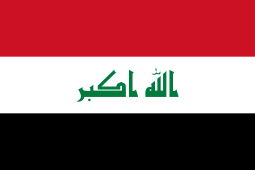 الله اكبر ("God is the greatest") | |
| Use | National flag and ensign |
|---|---|
| Proportion | 2:3 |
| Adopted | 31 July 1963 (original version) 22 January 2008[1] (current version) |
| Design | A horizontal tricolour of red, white, and black, charged with the takbīr (Allahu akbar, "God is [the] greatest") in green Kufic script, centered on the white stripe.
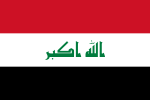 Reverse |
The flag of Iraq (Arabic: علم العراق) includes the three equal horizontal red, white, and black stripes of the Arab Liberation flag, with takbīr in Kufic script written in the center.
This basic tricolor has been in use since its adoption on 31 July 1963, with several changes to the green symbols in the central white stripes; the most recent version adopted on 22 January 2008[1] bears the takbīr rendered in dark green.
The flag has been changed over the years.
The flag between 1963 and 2008 had three green stars, since 2008 the stars have been removed.
Color scheme[]
Valid for Iraqi flags 1963–present.
| Red | White | Green | Black | |
|---|---|---|---|---|
| RGB | 206/17/38 |
255/255/255 |
0/122/61 |
0/0/0
|
| Hexadecimal | #ce1126 |
#ffffff |
#007a3d |
#000000
|
| CMYK | 0/92/82/19 |
0/0/0/0 |
100/0/50/52 |
0/0/0/100
|
History[]
1921–1959[]



The first flag of modern Iraq was in Mandatory Iraq, and was adopted in 1921. It was a black-white-green horizontal flag, with a red triangle extending from the mast side, inspired by the flag of the Arab Revolt. It was soon changed to a new version with a red trapezoid replacing the triangle and two seven-point white stars on denoting the Tigris River, and the Euphrates River. Both designs also reflected the newly installed Hashemite Dynasty in Iraq (originally from Hejaz in the Arabian Peninsula), who had played a leading role in the Arab Revolt. As such, it was similar to the flags of Hashemite Jordan, and the short-lived Kingdom of Hejaz.[2][3] The new flag continued to be used in the Kingdom of Iraq.
1958[]

In 1958, in response to the merger of Egypt and Syria in the United Arab Republic, the two Hashemite kingdoms of Iraq and Jordan established the Arab Federation, a confederation of the two states. The flag of the union was essentially that of Jordan but without seven pointed star in the red chevron.[4] This flag is identical to the flag of Palestine adopted in 1964, and almost identical to the flag of the Ba'ath Party. The union lasted less than six months, being terminated by the Iraqi Revolution of 1958 in July.
1959–1963[]
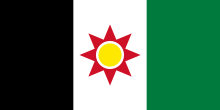
Following the Revolution of 14 July 1958, led by Abd al-Karim Qasim, which abolished the Hashemite monarchy in Iraq and turned the country into a republic, Iraq adopted a new flag (Law 102 of 1959) that consisted of a black-white-green vertical tricolour, with a red eight-pointed star with a yellow circle at its centre. The black, white, green, and red are the Pan-Arab colors, representing pan-Arabism, with the yellow Kurdish Sun in the middle to represent the Iraqi Kurds, surrounded by the red Star of Ishtar to represent ancient Mesopotamian history. [5][6][7]
This version of the Iraqi flag is currently the only Iraqi flag that’s allowed to be flown in the Kurdish Autonomous Region of Iraq, because it’s the only one that gives Kurdish representation, while other versions are not, due to their connotations of pan-Arabism, and their adoption during the period of Ba'ath Party rule.[8]
1963–1991[]
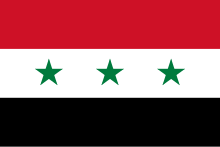
After Qassim was overthrown by the Ba'ath Party in 1963, the new Ba'athist government adopted a modified version of the Arab Liberation flag as the new flag of Iraq on 31 July 1963 (Law 28 of 1963). This horizontal tricolour of red, white, and black bands (first used in the Egyptian Revolution of 1952) formed the basis of the flag of the United Arab Republic (UAR). Though the UAR broke up in 1961, hopes for Arab unity persisted. As such, whereas the UAR flag had two green stars in the white band, signifying its two members (Egypt and Syria), the new Iraqi flag had three stars, symbolising the aspiration that Iraq would join with Egypt and Syria in a new union. Sharing this goal, Syria adopted the new Iraqi flag as its own later that same year. This remained the flag of Syria until 1971, when the green stars were replaced by the Hawk of Quraish as the Coat of arms of Syria.
The Iraqi Flag Law No. 28 of 1963 was replaced by Flag Law No. 33 of 1986, during the presidency of Saddam Hussein, in which although the flag remained the same, the meaning of the three stars was changed from their original geographic meaning to representations of the three tenets of the Ba'ath Party motto: wahda, hurriyah, ishtirakiyah (unity, freedom and socialism).
1991–2004[]

On 13 January 1991, the flag was modified by Flag Law No. 6 of 1991. At the instigation of President Saddam Hussein, the takbīr (the phrase Allahu akbar, meaning "God is the greatest" in Arabic) was added in green between the stars. The form of the takbīr was said to be Saddam's own handwriting.[9] Many[who?] interpreted the addition of the sacred Islamic text as an attempt to garner wartime support from previously outlawed religious Iraqi leaders, to stop the disrespect of the Iraqi flag in Iraqi-occupied Kuwait, and to bolster the Iraqi government's Islamic credentials in the period immediately preceding the Persian Gulf War.[citation needed]
As with other flags inscribed with Arabic script, the hoist is to the right of the obverse (front) of the flag.
2004–2008[]

Owing to differing views on a flag proposed by the United States-appointed administration, and the prevailing opposition to an outright abandonment of the current Iraqi flag, a compromise measure was adopted by the U.S.-appointed Iraqi interim administration in 2004. The basic form of the existing flag was retained;[10] however, the takbīr was rendered in traditional stylized Kufic script, as opposed to the handwriting of Saddam Hussein.
The modified flag was unveiled at the ceremony marking the technical "handover" of power from the Coalition Provisional Authority occupation forces to the U.S.-appointed administration on 28 July 2004.[11]
2008–present[]

On 22 January 2008,[1] the Council of Representatives of Iraq approved its new design for the National Flag was confirmed by Law 9 of 2008 as the compromise temporary replacement for the Ba'athist Saddam-era flag. In this current version, the three stars were removed. The parliament intended that the new design last for one year, after which a final decision on the flag would be made. However, the flag law was reviewed in parliament on 30 August 2009.[12]
In 2012, there was an effort to replace the flag with a new design.[13]
Flag proposals and flag contest[]
2004 flag proposal and controversy[]
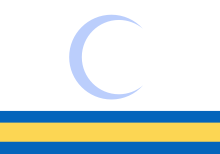
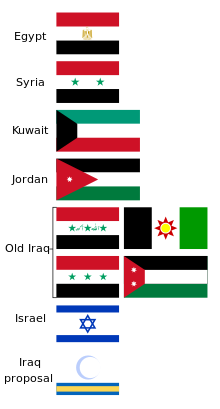
Following the invasion and occupation of Iraq by the United States in 2003, the Iraqi government was overthrown, and the Ba'ath Party was outlawed. Strong speculation followed that the U.S. government would press for a change in the Iraqi flag to remove its pan-Arab symbolism, and to make a definitive break with the period of Ba'athist rule. To a degree, this view was shared by some groups in Iraq. In addition to some displeasure among Iraqis who had suffered under Saddam Hussein to retaining national symbols used by his government, there was also strong aversion to the flag from Iraq's Kurdish minority, who resented its evocation of pan-Arabism. However, Iraqi opponents of changing the flag argued that since the flag had been used since 1963, long before Saddam Hussein's presidency, it was unfair to characterise it as a "Saddamist" flag. They also stressed that pan-Arabism has been a dominant popular principle among Iraqi's majority population for decades prior to Iraqi independence in 1932.
On 14 August 2004 the U.S.-appointed Iraqi Governing Council (IGC) announced a new flag during Saddam's Iraq. The IGC stated that, from around 30 competing entries, it had chosen a design by the distinguished Iraqi artist-architect Rifat Chadirji, who lived in London, and is a brother of a member of the IGC.
The proposed flag had several meanings:
| Symbol | Meaning |
|---|---|
| White background | Purity |
| Two blue bands | The blue bands represent the Tigris and the Euphrates rivers. |
| Yellow band | Kurdish minority. The flag of Kurdistan features a yellow sun. |
| Blue crescent | The crescent represents Islam. The shade of blue represents Iraqi Turkmens. |
The design marked a notable break with the three flags of modern Iraqi history (namely the Arab Revolt-inspired flag of the Kingdom, the flag introduced by Abd al-Karim Qasim, and the Arab Liberation inspired flag of 1963), all of which were based on the four Pan-Arab colors. Indeed, of these colours, only white was represented in the IGC design. Moreover, Islamic crescents are usually depicted in green or red in Arab heraldry. The proposed change provoked an intensely negative reaction across groups of Iraq's Arab majority, including those vehemently opposed to Saddam Hussein. Those opposed to the U.S. occupation, including Shi'a cleric Muqtada al-Sadr, decried the design as an attempt by the U.S. government to strip Iraq of its identity, and its historically prominent role in the Arab world. In particular, critics lamented the proposed abandonment of the Arab Liberation Flag, the omission of the traditional colors of pan-Arabism, and the removal of the takbīr.
Additionally, the new flag's predominantly blue-on-white appearance immediately antagonised many in Iraq because of its alleged resemblance to the flag of the State of Israel, considered hostile to Iraq since the former's establishment in 1948.
The new flag was reported to have been burned by insurgents in Fallujah on 27 April 2004, the day before its planned official adoption.
On 28 April 2004, IGC President Masoud Barzani formally presented a modified version of the flag in which the originally very light shade of blue as reported by the press on 26 April 2004 had been changed to a darker tone. It was unclear whether this was a change made because of the protests made against the original design or, as the Council claimed, a rectification of printing errors in the earlier news reports. Barzani also explained that the flag was a temporary design, to be used over the ensuing months until the adoption of a definitive flag.
In the face of the overwhelming public outcry, adoption of the blue crescent flag was abandoned entirely.
2008 flag proposal[]

Despite the compromise in 2004, opposition to the flag persisted from Kurdish groups. In January 2008, a new design was proposed, removing the three green stars, instead placing a green eight pointed star around a yellow circle in the middle of the takbīr, which is written in the Kufic script and prized as a Mesopotamian Arabic style, having originated in Iraq.[14]
2008 flag contest[]

In July 2008, the Iraqi parliament launched a contest to design a new Iraqi flag. The contest ran until September 2008, with 50 designs submitted. Six designs were chosen and sent to the parliament which was going to choose a new flag before the end of 2008.[15]
Another design was also proposed similar to the 2004–2008 flag, but the script was changed to yellow to represent the Kurdish people in northern Iraq. The meaning of the three stars would be changed to symbolize peace, tolerance and justice.[16]
Subnational flag[]
Regions[]
| Flag | Date | Use | Description |
|---|---|---|---|
 |
1992 | Flag of Kurdistan, used in Iraqi Kurdistan | Ratio: 2:3 |
Governorates[]
| Flag | Date | Use | Description |
|---|---|---|---|
 |
Flag of Baghdad Governorate | Ratio: 2:3 | |
 |
Flag of Basra Governorate | Ratio: 2:3 |
See also[]
- Coat of arms of Iraq
- Pan-Arab colors
- Flag of the Arab Revolt
- Flag of Egypt
- Flag of Jordan
- Flag of Kuwait
- Flag of Palestine
- Flag of Sudan
- Flag of Syria
- Flag of the United Arab Emirates
- Flag of Yemen
References[]
- ^ Jump up to: a b c d FOTW
- ^ ben cahoon. "Iraq". Worldstatesmen.org. Retrieved 2020-05-29.
- ^ "Vexilla Mundi". Vexilla Mundi. Retrieved 2020-05-29.
- ^ "Archived copy". Archived from the original on 2008-08-09. Retrieved 2008-08-09.CS1 maint: archived copy as title (link)
- ^ Peter Symes. "The First Banknotes of the Central Bank of Iraq". Pjsymes.com.au. Retrieved 8 January 2018.
- ^ Dawisha, Adeed (1 January 2003). "Requiem for Arab Nationalism". Middle East Quarterly. Retrieved 9 January 2018.
- ^ Amatzia Baram, "Mesopotamian Identity in Ba'thi Iraq," Middle Eastern Studies, Oct. 1983, p. 427.
- ^ Today's Zaman Archived August 25, 2009, at the Wayback Machine
- ^ Podeh, Elie; Pôde, Ēlî (2011-06-30). The Politics of National Celebrations in the Arab Middle East. Cambridge University Press. p. 144. ISBN 9781107001084.
- ^ "Republic of Iraq flag". World flags 101. Retrieved 2008-02-10.
- ^ "CNN.com - U.S. returns sovereignty to Iraq - Jul 28, 2004". Archived from the original on August 3, 2004.
- ^ "Council of Representatives of Iraq (parliament) schedule includes Iraqi law review on April 30, 2009. (in Arabic)". Council of Representatives of Iraq. 2009-04-29. Retrieved 2009-04-29.
- ^ "Iraq aims to unite with new national anthem, flag". The Daily Star. 24 September 2012. Retrieved 9 January 2018.
- ^ Garrels, Anne (2008-01-12). "Iraq to Restore Former Baath Party Followers". National Public Radio. Retrieved 2008-01-24.
- ^ "Iraqi new flag to be identified before year end". Patriotic Union of Kurdistan. 2008-10-12. Retrieved 2008-10-12.
- ^ Charif, Chalaan (2008-01-15). "Iraq's new flag half satisfies everyone". Radio Netherlands. Archived from the original on 2008-01-18. Retrieved 2008-01-24.
External links[]
| Wikimedia Commons has media related to Flags of Iraq. |
- Iraq parliament approves new flag
- Iraq unveils new national flag (BBC)
- Controversial new Iraqi flag unfurled (al-Jazeera)
- Iraqis unimpressed by flag design (BBC; refers to the sibling relationship between the al-Chaderchis, accusations of nepotism)
- Burning with anger: Iraqis infuriated by new flag that was designed in London (The Independent, reaction of Iraqis, sibling relationship)
- Flags of Modern Iraq (Arabic-Radio-TV, The Flags of Modern Iraq (1921–present)
- Iraq at Flags of the World
- New York Times article on new flag
- Global Justice Project: Iraq
- Flags of Iraq
- National symbols of Iraq
- National flags
- Flags adopted through competition
- Flags including Arabic script
- Flags introduced in 1963
- Flags introduced in 1991
- Flags introduced in 2004
- Flags introduced in 2008

